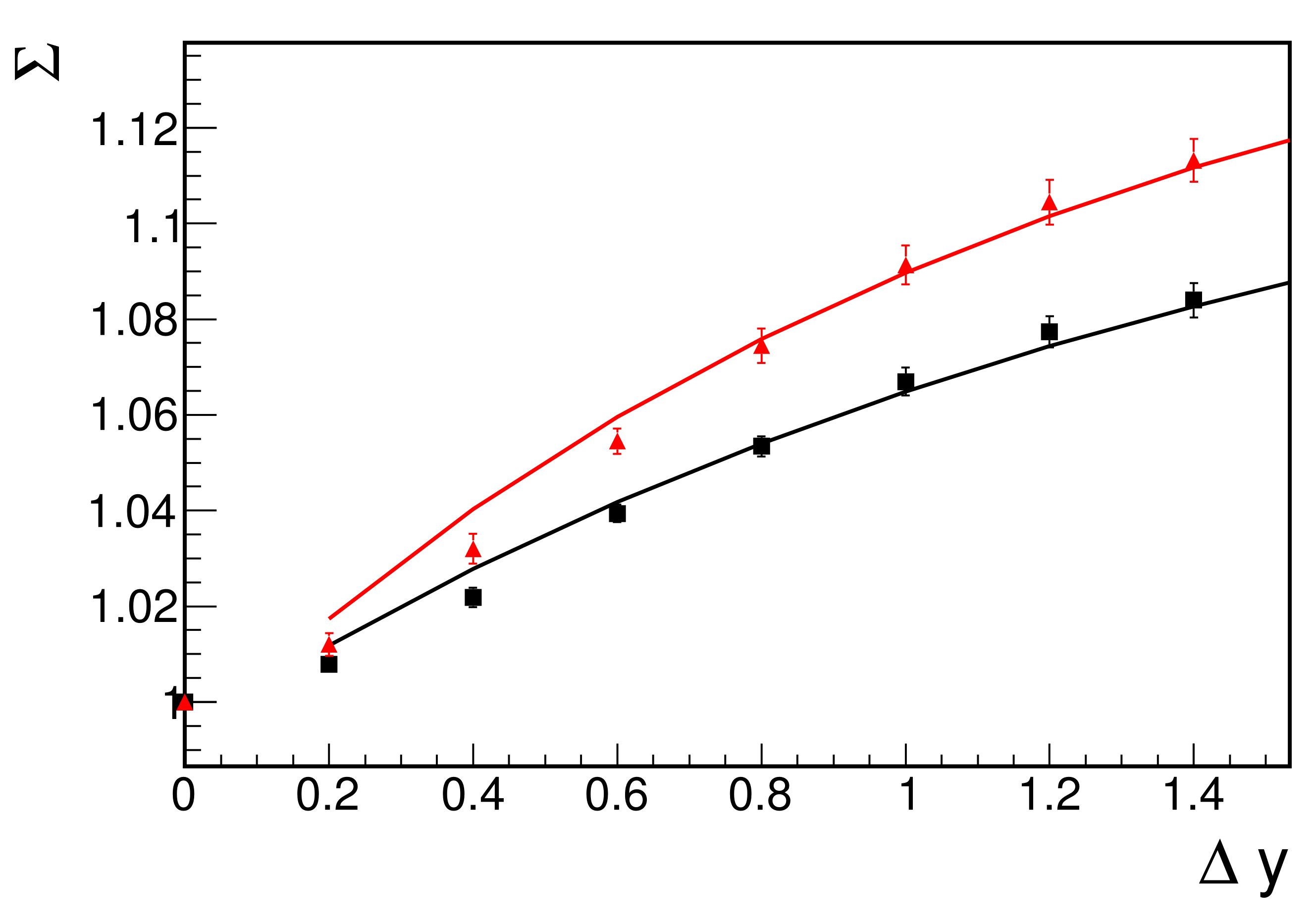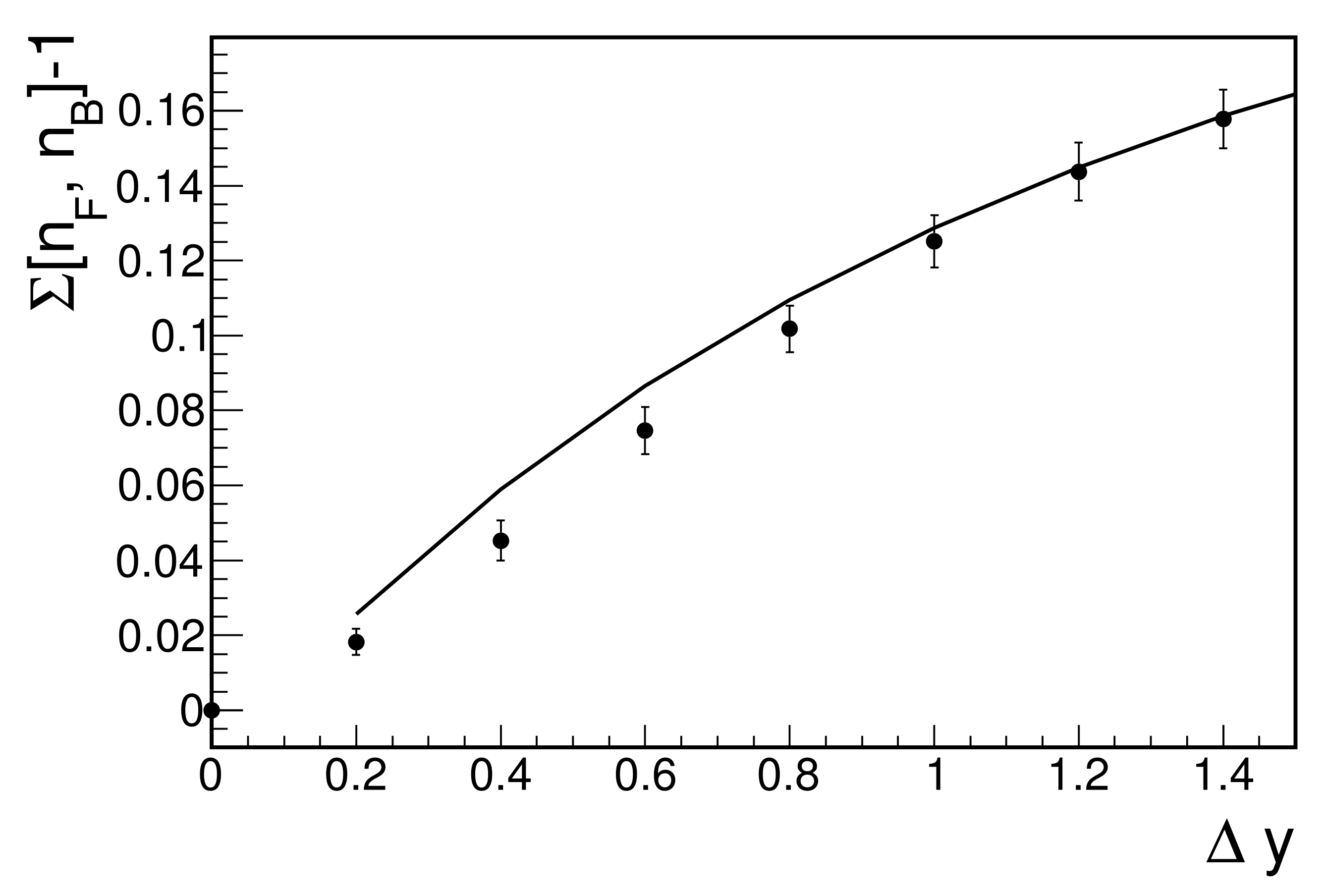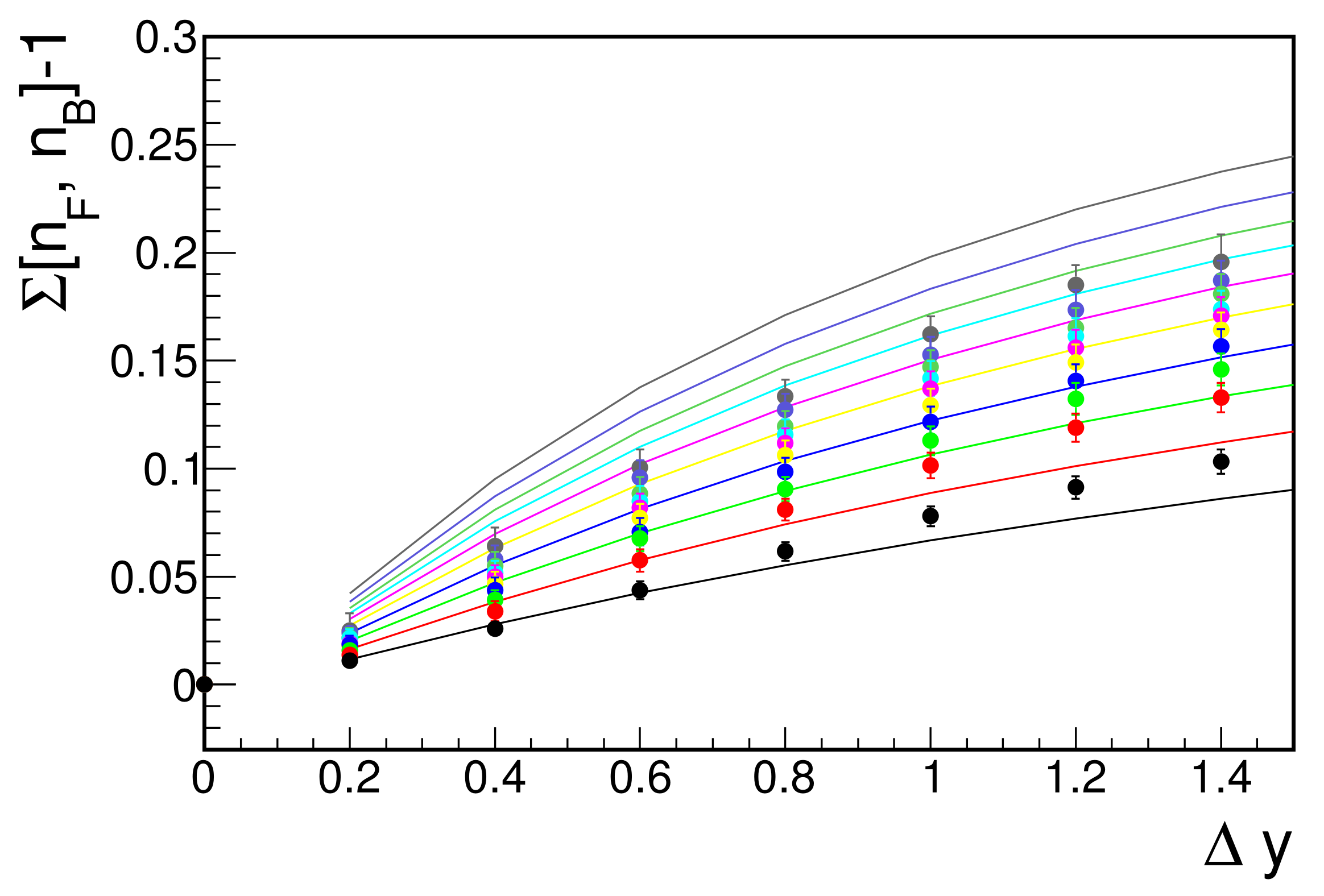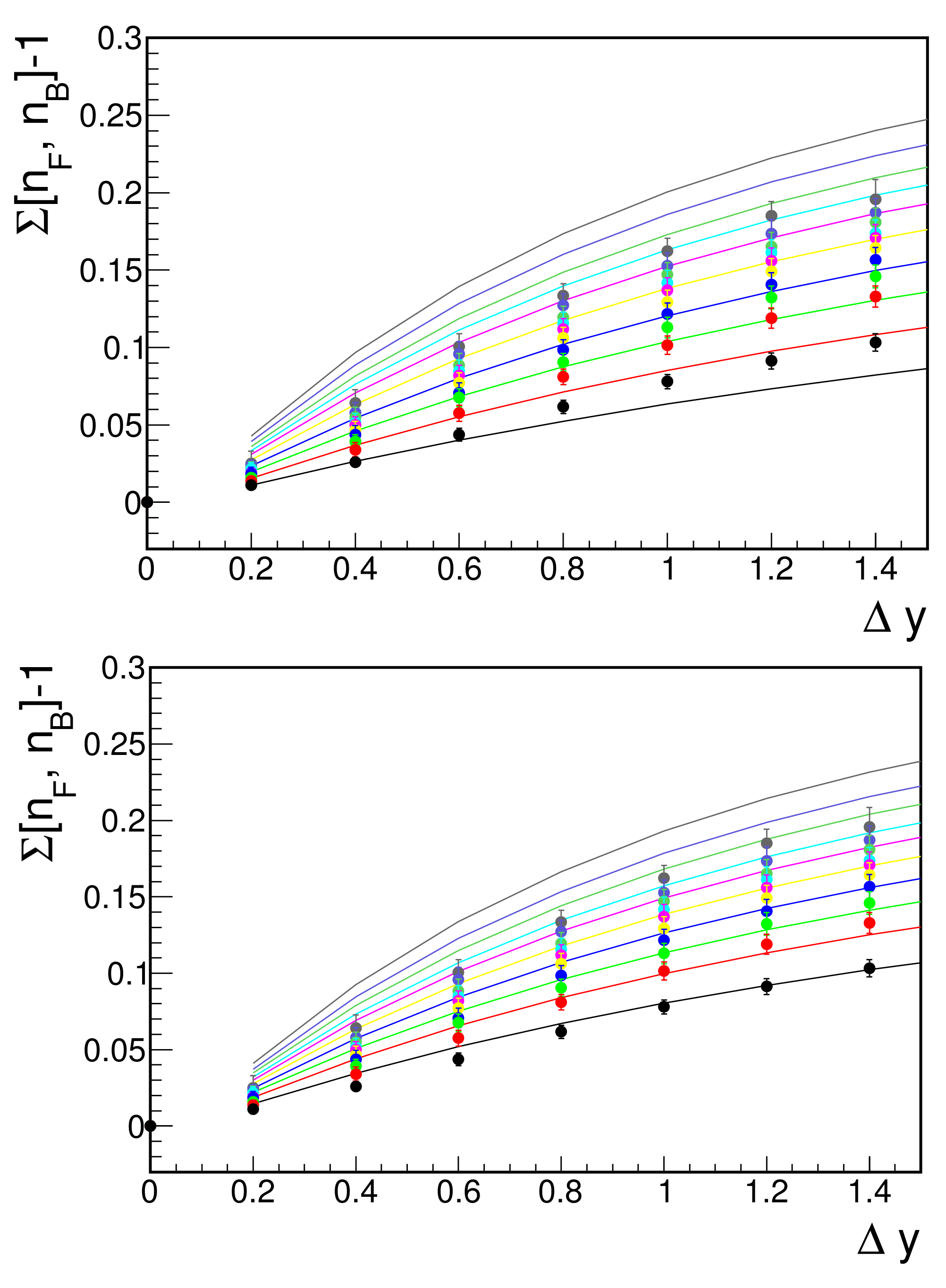1. Introduction
At present, the semiphenomenological model of quark-gluon strings understood as color flux tubes [
1,
2] is the standard approach for describing the soft part of hadronic interactions at high energies. Various versions of the string model are used in such Monte Carlo (MC) event generators as PYTHIA, VENUS, HIJNG, AMPT, EPOS, DIPSY etc., to describe soft processes in strong interactions when QCD perturbation theory does not work.
However, now the model is gaining more and more recognition in which at high string density, for example, at high energies in nucleus-nucleus collisions, the strings begin to overlap in the impact parameter plane due to their finite area in the transverse plane. This leads to the need to take into account the interaction between strings, which leads, in particular, to the processes of their merging and the formation of string clusters (“colored ropes”) [
3,
4,
5,
6]. In this paper, we show that, at LHC energies, string fusion processes also play an important role in pp interactions.
In [
7], as one of the tools for studying the effects of string fusion, it was proposed to study the so-called forward-backward (FB) correlations between the numbers of particles detected in two separated rapidity intervals. Usually these two intervals (the observation windows) are chosen symmetrically, one in the forward and the other in the backward hemisphere of the reaction. Indeed, it is known that studies of long-range rapidity correlations provide information about the very initial stages of hadronic collisions [
8] and, in particular, about the string configuration formed in a given collision.
Unfortunately, it was already shown in [
9] that the traditional coefficient FB of correlations between multiplicities of charged particles,
and
, in rapidity observation windows strongly depends on the fluctuations of the number of cut pomerons (the number of strings) from event to event in pp-collisions, i.e., from the so-called “volume fluctuations”—trivial fluctuations in the number of sources. From this point of view, it is necessary to use other observables that are insensitive to fluctuations in the number of sources (strings) but sensitive to fluctuations in the properties of these sources, in particular, to the formation of string clusters as a result of string fusion processes.
There are two ways to suppress the influence of these trivial “volume” fluctuations compared to the contribution of string fusion processes. You can either study correlations including intensive variables, such as, for example, the event-average transverse momenta
and
of all charged particles detected in a given event, respectively, in the observation rapidity windows
and
(instead of their multiplicities
and
), as in [
10,
11,
12,
13,
14,
15]. Alternatively, you can introduce a more complex correlation observable between
and
. This article is devoted to the development of this second approach.
2. Strongly Intense Observable
General methods for constructing so-called strongly intense observables—variables that are not affected by “volume” fluctuations are developed in [
16]. Later it was proposed [
17] to investigate the strongly intense quantity
, defined for the multiplicities of charged particles,
and
, in two observation windows
and
:
where
is the normalized (scaled) variance,
is the variance, and
. For the case of a symmetrical collision and symmetrically located identical observation windows,
=
=
(the corresponding azimuthal extent of these windows is assumed to be
), we have
and the expression (
1) can be reduced to
Earlier in [
18] it was shown that in the model with independent identical strings, the observable
depends only on the parameters of a single string-one- and two-particle rapidity distributions of particles produced from string decay:
Instead of
, it is sometimes more convenient to use the two-particle string correlation function defined as follows:
The last transitions in these formulas correspond to an approximation that also assumes the presence of translational invariance in rapidity, which is well satisfied in the region of central rapidities at LHC energies.
In [
18] it was shown that in the model with independent identical strings
where
is the strongly intensive variable
, defined similarly to (
1), but for a single string. Here
and
are the number of particles from the decay of a single string falling into the forward
and backward
observation windows, respectively.
is expressed in terms of string parameters (
4) and (
5) using formulas
where
For symmetrically located rapidity windows it depends on the acceptance of the observation windows,
=
=
, and the rapidity distance,
, between the centers of these windows, so
. In the particular case of symmetric windows of small width,
, the formula (
7) is simplified to
The formulas (
6) and (
7) show that, in the framework of the model with independent identical strings, the variable
is indeed a strongly intensive quantity. Its value coincides with the value for a single string
, which depends only on the parameters of this string and does not depend on the number of strings formed in a given event, nor on the fluctuation of their number from event to event.
Later, in a version of the model [
19] that takes into account the processes of string fusion and the formation of string clusters of various types, it was found that the observable
turns out to be equal to the weighted average of its values for different string clusters,
, consisting of
k strings, with weight coefficients,
, depending on the details of the collision, namely its energy and centrality:
The value of a strongly intense variable,
, for a given string cluster of
k strings is expressed in terms of its characteristics: the average density of charged particles produced per unit of rapidity from its decay,
, and the pair correlation function,
, characterizing the correlations between two particles produced at a rapidity distance
. This dependence is analogous to (
7)
where
For sufficiently narrow observation windows
, this dependence is analogous to (
9) and has the following simple form:
Recall that
is the rapidity distance between the centers of these windows.
For the pair correlation function of the cluster,
, formed from
k strings, we used the simplest, exponential parametrization:
where
, and
is the characteristic correlation length in rapidity between particles born from this cluster.
As shown in [
19], the weight coefficients
in formula (
10),
are the average fraction of particles formed as a result of the decays of all clusters formed by the fusion of
k strings, with the first term at
corresponding to the contribution of single strings. Obviously, with a change in the initial energy and centrality of pp-collisions, the fraction of clusters corresponding to a different number of merged strings will change, which will lead to a change in the weights
and, consequently, according to (
10), to a change in the observable
.
Therefore, in a model that takes into account the possibility of the formation of sources of different types, the observable , strictly speaking, ceases to be strongly intense, starting to depend through the weights of on the collision conditions, in particular, on the degree of its centrality and initial energy. Nevertheless, as we will see below, the study of the dependence of the variable on the rapidity distance between the centers of observation windows of a given width under various collision conditions allows us to determine the characteristics of string clusters.
3. String Distribution in the Transverse Plane and the Formation of String Clusters
To find the dependence of the weight coefficients
on the collision conditions, we used the MC simulation of pp-collisions at LHC energies within the framework of the string model. The generation of string configurations arising in pp-collisions by the MC method was carried out on the basis of the approach proposed earlier in the article [
20]. It is important that this approach makes it possible to fix the location of primary strings in the transverse plane in each event, which is necessary for calculating the processes of their merging leading to the formation of string clusters.
To take into account string fusion processes, we used the method proposed in [
21,
22], which is based on the use of a finite lattice (grid) in the impact parameter plane, similarly to how it is described in [
19,
23]. Within the framework of this approach, it is assumed that all
k strings whose centers occur in the same cell of this grid merge into a single string cluster. In accordance with the prescriptions of the string fusion model [
6], the following dependence of the average number of particles
formed upon the decay of a cluster on the number of merged strings
k is assumed:
where
and
are average rapidity densities of particles produced, respectively, from the hadronization of a
k-string cluster and one single string, and
is the rapidity width of the observation window.
Since, according to (
16), the rapidity density of charged particles from the decay of a string cluster is assumed to be proportional to
and correlations take place only between adjacent segments of a string cluster, it is reasonable to assume that the characteristic correlation length
decreases with
k as
. Some additional arguments in favor of this assumption were presented in [
18]. Therefore, we will assume the following dependence of the parameters of the correlation function of the string cluster on
k:
Formulas (
16) and (
17) allow us to calculate the parameters of a string cluster formed by merging of
k strings from three parameters:
, characterizing a single string (
14).
In present work, using MC-simulation of pp-collisions, as described in [
20,
23,
24], we sequentially generate string distributions in the transverse plane, take into account the formation of string clusters, and calculate the weight coefficients
as the average fraction of particles formed from the decays of clusters consisting of
k strings:
Here
is the average number of clusters consisting of
k strings, which we find by generating string configurations for given pp-collision conditions. Then we computed
using the formula (
10).
4. Fixing Parameters of String Clusters
To fix the remaining free parameters of the model we calculated the dependence of the variable
, on the size of the gap
between rapidity observation windows of small width (
) for minbias pp collisions at two initial energies, 0.9 and 7 TeV, and compared the calculation results with the preliminary experimental data of the ALICE collaboration for
[
25], obtained by the analysis of the production of charged particles in the soft region of the spectrum with transverse momenta in the range 0.3–1.5 GeV/
c (see
Figure 1).
This comparison made it possible to extract the values of the remaining free parameters; the three parameters for a single string in the dependences (
16) and (
17), characterizing clusters with different numbers of merged strings:
With the parameters of string clusters fixed in this way, we calculated the variable
for the case of min-bias pp collisions at the initial energy 13 TeV and compared the model results with the ALICE experimental data [
25]. Note that, since the analysis of these data at 13 TeV in the ALICE experiment was carried out for a wider range of transverse momenta 0.2–2 GeV/
c, which is currently used in the ALICE collaboration when analyzing the production of charged particles in the soft region of the spectra, then to take into account increase in the total multiplicity of particles, the coefficient
was increased according to [
26] by a factor of 1.28 to the value
. At the same time, the values of all other parameters of the model were saved.
In
Figure 2 we see that this set of parameters also successfully describes the dependence of the observable
on the rapidity distance between the centers of observation windows,
, at initial energy 13 TeV.
The slight overestimation of
in
Figure 1 and
Figure 2 at small values of
, as also in the bottom plot of Figure 4 below in
Section 5, can be explained by using a simplified (exponential) approximation for the two-particle correlation function of a string cluster (see formula (
14)). It was shown in [
27] that the exponential form of approximation for the rapidity dependence of the two-particle correlation function of the string leads to a slight overestimation of the FB correlation coefficient in the region of the forward correlation peak at small values of
(see plots for azimuth angle 45
in [
27]).
Comparing the dependences at initial energies of 0.9, 7 and 13 TeV presented in
Figure 1 and
Figure 2, we see that in pp collisions at LHC energies, string fusion effects have a significant effect on the behavior of the strongly intense observable
, and the growth of this variable with initial energy is explained by the increasing contribution from the formation of string clusters with new properties, consisting of an increasing number of merged strings.
5. Dependence of the Observable on the Centrality of the pp Collision
In this section, we analyze the dependence of the observable on the centrality of the pp-collision. Since in the case of real pp collisions the impact parameter b is not known, the experimental determination of the degree of centrality of a given pp collision can be carried out only by indirect indications. Therefore, the division of the array of all min-bias pp events into the so-called centrality classes depends on the applied experimental procedure.
In the ALICE experiment at LHC, with the results of which we compare our theoretical calculations, a signal from a special detector V0 (in arbitrary units) is used to determine the degree of centrality of a given pp collision [
28,
29]. This detector consists of a pair of plastic scintillation counters V0A and V0C located on either side of the interaction point.
The events are classified using the total energy deposition in the V0 detector, so-called “V0M amplitude”, which is proportional to the total number of charged particles passing through the V0A and V0C detectors. Thus, in ALICE, the centrality classes in pp-collisions are determined by the multiplicity in the acceptance of the V0A and V0C detectors and are often called multiplicity classes. The multiplicity classes are defined as percentile intervals of the experimental distribution of the V0M amplitude (see details in [
28,
29]).
To imitate this procedure in our MC model calculations we first carried out a preliminary MC simulation of 1,000,000 min-bias pp events, determining the multiplicity
N in a fixed rapidity interval, corresponding to the total acceptance of V0A and V0C detectors. Then to generate the continuous signal, V0M amplitude, corresponding to this multiplicity
N (note that the
N is always an integer number), we use a detector response function:
which is typical for detectors of this kind (see e.g., [
30]. Here
gives the probability density of registering a signal
V from the detector V0 when
N charged particles hit it. The
-function indicates that the signal
V is always positive
.
C is the normalization constant.
Note that in the limit
we have
and
It can be seen from formulas (
21) and (
22) that the average value of the signal,
, is proportional to the number of particles
N that hit the detector, and the parameter
characterizes the magnitude of the signal smear around this average value. We also see that the relative error,
, in determining the
V decreases with
N as
.
Using the distribution (
20), we generate the V0M = V0A + V0C detector response,
V, for the number of charged particles,
N, hitting it, for each event. Then using this value of the signal,
V, attributed to each event, we can split all events into centrality classes. Note that in this procedure the absolute value of the signal does not play a role, but only the relative value of
V for different events is important. Experimentally, in ALICE, the signal from the V0 detector is presented in arbitrary units. Thus, in our MC simulation, without loss of generality, we can set the parameter
to be equal to 1.
In order to be able to compare the results of our theoretical calculations with the experimental data of the ALICE collaboration, we chose rather narrow centrality classes, as this was done in the work [
25] and in other ALICE papers [
28,
29]. This comparison for the observable
as a function of the distance in rapidity between the centers of the observation windows
for different centrality classes of pp collisions at initial energy 13 TeV is presented in
Figure 3 and
Figure 4, for three values of the parameter
characterizing the accuracy of the detector V0 (see formulas (
20)–(
22)).
It can be seen in
Figure 3 and
Figure 4 that our model with the formation of string clusters also makes it possible to reasonably describe experimental behavior of a strongly intense variable
for different centrality classes of pp-collisions at the same values of the parameters, characterizing string clusters.
At the same time, a comparison of the plot in
Figure 3 with the upper plot in
Figure 4 shows that the division of events into centrality classes, using the value of the parameter
and
, stays practically unchanged. The calculated curves for
in
Figure 3 practically coincides with the curves in upper plot of
Figure 4. Whereas using the value of the parameter
to characterize the detector V0 when splitting the array of events into centrality classes leads to better agreement with the experimental data, taking into account the rather large error bars of experimental points for the most central multiplicity classes (see the lower plot in
Figure 4) than using the values
and
.
Thus we see that the agreement between theory and experiment can be improved if we take into account the imperfection of the detector V0 used to split the array of events into centrality classes.
6. Conclusions
Within the framework of the model with quark-gluon strings (color flux tubes) as sources, the properties of the strongly intense variable , which characterizes the correlations between the number of particles, and , detected in pp interactions at LHC energies in two observation windows separated in rapidity were studied.
On the basis of analytical calculations supplemented by MC modeling, which makes it possible to take into account string fusion processes by introducing a grid in the impact parameter plane, the dependence of the variable
on the rapidity distance
between the centers of observation windows with a given width
is calculated for initial energies: 0.9, 7 and 13 TeV and different centrality classes of collisions. The results of theoretical calculations are compared with the preliminary experimental ALICE data for
[
25], obtained by analyzing the production of charged particles in pp collisions at the LHC.
It is shown that the proposed model with the formation of string clusters makes it possible to adequately describe the experimental behavior of the strongly intense variable both for different initial energies and for different centrality classes of pp-collisions with the same values of the parameters, characterizing string clusters.
It is important to note that, due to the strongly intense nature of the observable
, if there were no merging of strings and the formation of string clusters in pp collisions, but simply a fluctuation in the number of single strings from event to event, then we would not observe any modification in the dependence of
on
with initial energy and centrality of pp collision. In
Figure 1,
Figure 2,
Figure 3 and
Figure 4 we would have the same curve defined only by the parameters of a single string, as it follows from the formulas (
6)–(
9). (The same can be seen from the formula (
10) with
for
). The splitting of the curves in these figures is explained exclusively by the increasing contribution from the formation of string clusters with new properties, consisting of an increasing number of merged strings with an increase in the initial energy and centrality of pp collisions, as follows from the formula (
10).










